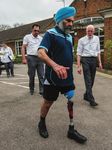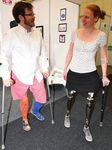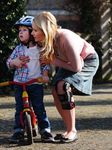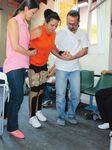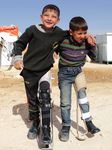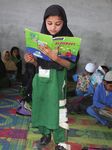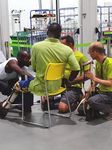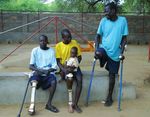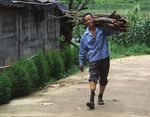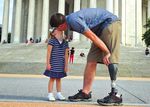Part 1: STANDARDS - WHO | World Health Organization
←
→
Page content transcription
If your browser does not render page correctly, please read the page content below
STANDA RDS F OR PROS T HET ICS AND O RT HO T IC S • PART 1. STAN D AR D S
WHO standards for prosthetics and orthotics
Contents: Part 1. Standards; Part 2. Implementation manual
ISBN 978-92-4-151248-0
© World Health Organization 2017
Some rights reserved. This work is available under the Creative Commons Attribution-NonCommercial-ShareAlike 3.0 IGO licence (CC BY-NC-SA 3.0 IGO; https://
creativecommons.org/licenses/by-nc-sa/3.0/igo).
Under the terms of this licence, you may copy, redistribute and adapt the work for non-commercial purposes, provided the work is appropriately cited, as indicated below.
In any use of this work, there should be no suggestion that WHO endorses any specific organization, products or services. The use of the WHO logo is not permitted. If
you adapt the work, then you must license your work under the same or equivalent Creative Commons licence. If you create a translation of this work, you should add
the following disclaimer along with the suggested citation: “This translation was not created by the World Health Organization (WHO). WHO is not responsible for the
content or accuracy of this translation. The original English edition shall be the binding and authentic edition”.
Any mediation relating to disputes arising under the licence shall be conducted in accordance with the mediation rules of the World Intellectual Property Organization.
Suggested citation. WHO standards for prosthetics and orthotics. Geneva: World Health Organization; 2017. Licence: CC BY-NC-SA 3.0 IGO.
Cataloguing-in-Publication (CIP) data. CIP data are available at http://apps.who.int/iris.
Sales, rights and licensing. To purchase WHO publications, see http://apps.who.int/bookorders. To submit requests for commercial use and queries on rights and
licensing, see http://www.who.int/about/licensing.
Third-party materials. If you wish to reuse material from this work that is attributed to a third party, such as tables, figures or images, it is your responsibility to
determine whether permission is needed for that reuse and to obtain permission from the copyright holder. The risk of claims resulting from infringement of any
third-party-owned component in the work rests solely with the user.
General disclaimers. The designations employed and the presentation of the material in this publication do not imply the expression of any opinion whatsoever
on the part of WHO concerning the legal status of any country, territory, city or area or of its authorities, or concerning the delimitation of its frontiers or boundaries.
Dotted and dashed lines on maps represent approximate border lines for which there may not yet be full agreement.
The mention of specific companies or of certain manufacturers’ products does not imply that they are endorsed or recommended by WHO in preference to others of a
similar nature that are not mentioned. Errors and omissions excepted, the names of proprietary products are distinguished by initial capital letters.
All reasonable precautions have been taken by WHO to verify the information contained in this publication. However, the published material is being distributed
without warranty of any kind, either expressed or implied. The responsibility for the interpretation and use of the material lies with the reader. In no event shall WHO
be liable for damages arising from its use.
Design and layout by L’IV Com Sàrl, Villars-sous-Yens, Switzerland.
Printed in France.
iiContents
Contributors . . . . . . . . . . . . . . . . . . . . . . . . . . . . . . . . . iv
Abbreviations and acronyms . . . . . . . . . . . . . . . . . . . . . . . . . . . v
Definitions . . . . . . . . . . . . . . . . . . . . . . . . . . . . . . . . . . vi
Preface . . . . . . . . . . . . . . . . . . . . . . . . . . . . . . . . . . . ix
Executive summary . . . . . . . . . . . . . . . . . . . . . . . . . . . . . . xi
About this document . . . . . . . . . . . . . . . . . . . . . . . . . . . . . . xv
Introduction . . . . . . . . . . . . . . . . . . . . . . . . . . . . . . . . xxiii
Area 1. Policy . . . . . . . . . . . . . . . . . . . . . . . . . . . . . . . . . . 1
1.1 Leadership and governance . . . . . . . . . . . . . . . . . . . . . . . . 1
1.2 Financing . . . . . . . . . . . . . . . . . . . . . . . . . . . . . . 4
1.3 Information . . . . . . . . . . . . . . . . . . . . . . . . . . . . . . 5
1.4 Promotion of prosthetics and orthotics services . . . . . . . . . . . . . . . 6
Area 2. Products. . . . . . . . . . . . . . . . . . . . . . . . . . . . . . . . 11
2.1 Types . . . . . . . . . . . . . . . . . . . . . . . . . . . . . . . . 11
2.2 Supply of materials . . . . . . . . . . . . . . . . . . . . . . . . . . 12
2.3 Technical standards . . . . . . . . . . . . . . . . . . . . . . . . . . 13
2.4 Research and development . . . . . . . . . . . . . . . . . . . . . . . 14
Area 3. Personnel . . . . . . . . . . . . . . . . . . . . . . . . . . . . . . . 17
3.1 Personnel who provide prosthetics and orthotics services . . . . . . . . . . . 17
3.2 Training in prosthetics and orthotics . . . . . . . . . . . . . . . . . . . 18
3.3 Planning the prosthetics and orthotics workforce . . . . . . . . . . . . . . 19
3.4 Professional regulation and recognition . . . . . . . . . . . . . . . . . . 20
Area 4. Provision of services . . . . . . . . . . . . . . . . . . . . . . . . . . . 23
4.1 User-centred service delivery . . . . . . . . . . . . . . . . . . . . . . 23
4.2 Systems for delivering services . . . . . . . . . . . . . . . . . . . . . 24
4.3 Service units . . . . . . . . . . . . . . . . . . . . . . . . . . . . . 27
4.4 Service unit processes . . . . . . . . . . . . . . . . . . . . . . . . . 29
The way forward . . . . . . . . . . . . . . . . . . . . . . . . . . . . . . . 35
References . . . . . . . . . . . . . . . . . . . . . . . . . . . . . . . . . . 39
Annex 1. Summary of standards . . . . . . . . . . . . . . . . . . . . . . . . . 44
iiiSTANDA RDS F OR PROS T HET ICS AND O RT HO T IC S • PART 1. STAN D AR D S
Contributors
WHO steering group Alarcos Cieza, Pauline Kleinitz, Maryam Mallick, Satish
Mishra, Zafar Mirza, Andrea Pupulin, Hala Sakr, Emma
Tebbutt, and Armando Jose Vasquez
Standards development Girma Bireda Assena, Josephine Bundoc, Mary Anne
group Burke, Bishnu Maya Dhungana, Elaine Figgins, Ritu
Ghosh, Allen Ingersoll, Ev Innes, Friedbert Kohler,
Malcolm MacLachlan (Chair), William Neumann, Teap
Odom, Wesley Pryor, Youssef Salam, Daniel Suarez,
Claude Tardif and Nils-Odd Tønnevold
External review group Serap Alsancak, Firoz Ali Alzada, Jonathan Batzdorff,
Lee Brentnall, Helena Burger, Monica Castaneda,
David Condie, Sam Gallop, Olivia Giles, Jacqui Lunday
Johnstone, Jean Kagawa, Peter Kyberd, Aaron Leung,
Bryan Malas, Ana Paulina Chavira Mendoza, Longini
Mtalo, Masse Niang, Samuel Nkhoma, Nerrolyn
Ramstrand, Kerio Rapheal, Christian Schlierf, Pratima
Singh, Mel Stills and Isabelle Urseau
Executive editor Chapal Khasnabis
Lead authors Anders Eklund and Sandra Sexton
Additional contributions Dareen Barbar, Liu Bofei, Björn Ekman, Rajiv Hanspal,
Carson Harte, Kirsti Hoøen, Rob Horvath, V. Jayakodi,
Kylie Mines, Nisarat Opartkiattikul, Vinicius Delgado
Ramos, Albina Shankar, Bengt Söderberg, Camara
Yakouba and Husam Zeino
Systematic reviewers First review group led by Nachiappan Chockalingam and
Aoife Healy. Second review group led by Richard Baker,
Saeed Forghany and Ebrahim Sadeghi-Demneh
Technical editing Elisabeth Heseltine
Proof-reading Diane Bell and Angela Weatherhead
Cover photography China Assistive Devices and Technology Center for
Persons with Disabilities, Mobility India and Royal
National Orthopaedic Hospital-UK
Partner organizations International Society for Prosthetics and Orthotics and
United States Agency for International Development
Financial support Leahy War Victims Fund, United States Agency for
International Development
Administrative support Wendy Hamzai and Rachel McLeod-MacKenzie
ivAbbreviations and acronyms
CPD continuing professional development
CRPD Convention on the Rights of Persons with Disabilities
GATE Global Cooperation on Assistive Technology
ISO International Organization for Standardization
ISPO International Society for Prosthetics and Orthotics
SDG Sustainable Development Goal
USAID United States Agency for International Development
© Nancy Kules
vSTANDA RDS F OR PROS T HET ICS AND O RT HO T IC S • PART 1. STAN D AR D S
Definitions
Appropriate technology
Systems that provide fit and alignment that suit the needs of the individual and can be
sustained by the country at the lowest price. Proper fit and alignment should be based on
sound biomechanical principles (1).
Assistive products
Any external product (including devices, equipment, instruments and software), specially
produced or generally available, the primary purpose of which is to maintain or improve an
individual’s functioning and independence and thereby promote their well-being. Assistive
products are also used to prevent impairments and secondary health conditions (2).
Assistive technology
Organized knowledge and skills related to assistive products, including systems and services.
Assistive technology is a subset of health technology (2).
Disability
An umbrella term for impairments, limitations of activity and restrictions on participation
resulting from the interaction between people with health conditions and the environmental
barriers they encounter (3).
Health condition
An umbrella term for disease (acute and chronic), disorder, injury or trauma. Health
conditions may also include circumstances such as pregnancy, ageing, stress, congenital
anomaly or genetic predisposition (4).
Impairment
Loss of or abnormality in a body structure or physiological function (including mental
function), where “abnormality” is used to mean significant variation from established
statistical norms (4).
Multidisciplinary rehabilitation team
In the context of this document, rehabilitation provided by two or more different types of
rehabilitation professional.
Occupational therapy
Techniques to enable people to participate in the activities of everyday life by enhancing their
ability to engage in the occupations they want, need or are expected to do or by modifying
the occupation or the environment to support their occupational engagement (5).
viOrthosis, orthotic device or product
Externally applied device used to modify the structural and functional characteristics of the
neuromuscular and skeletal systems (6).
Orthotics
Science and art of treating people by the use of orthoses (6).
Orthotist
A person who has completed an approved course of education and training and is authorized
by an appropriate national authority to design, measure and fit orthoses (6).
People-centred care
An approach to care in which the perspectives of individuals, caregivers, families and
communities are consciously adopted so that people are participants in and beneficiaries
of trusted health systems that respond to their needs and preferences in humane, holistic
ways. People-centred care also requires that people have the education and support they
require to make decisions and participate in their own care. It is organized around the health
needs and expectations of people rather than diseases (7).
People with disability
People who have long-term physical, mental, intellectual or sensory impairments, which,
when they meet various barriers, may hinder their full, effective participation in society on
an equal basis with others (8).
Physiotherapy (sometimes referred to as physical therapy)
Services to individuals and populations to develop, maintain and restore maximum movement
and functional ability throughout the lifespan, including in circumstances where movement
and function are threatened by ageing, injury, pain, disease, disorders, conditions or
environmental factors. Functional movement is central to being healthy (9).
Prosthesis, prosthetic device or product
Externally applied device used to replace wholly or partly an absent or deficient limb
segment (6).
Prosthetics
Science and art of treating people by the use of prostheses (6).
Prosthetist
Person who has completed an approved course of education and training and is authorized
by an appropriate national authority to design, measure and fit prostheses (6).
viiSTANDA RDS F OR PROS T HET ICS AND O RT HO T IC S • PART 1. STAN D AR D S
Prosthetist and orthotist
Person who has completed an approved course of education and training and is authorized
by an appropriate national authority to design, measure and fit prostheses and orthoses (6).
In the context of this document, this term is also used to refer collectively to prosthetists,
orthotists and prosthetists and orthotists.
Rehabilitation
A set of interventions designed to optimize functioning and reduce disability in individuals
with health conditions in interaction with their environment (10). (See also Health condition.)
Universal health coverage
Universal health coverage is defined as “ensuring that all people can use the promotive,
preventive, curative, rehabilitative and palliative health services they need, of sufficient quality
to be effective, while also ensuring that the use of these services does not expose the user
to financial hardship” (11).
viiiPreface
Prostheses (artificial legs and hands) and orthoses (braces and splints) enable people with
physical impairments or functional limitations to live healthy, productive, independent,
dignified lives and to participate in education, the labour market and social life. The use of
prostheses or orthoses can reduce the need for formal health care, support services, long-
term care and caregivers. Without access to prostheses or orthoses, people who need them
are often excluded, isolated and locked into poverty, which increases the burden of morbidity
and disability.
The Convention on the Rights of Persons with Disabilities (CRPD) states that Member
States are responsible for taking effective measures to ensure personal mobility for the
greatest possible independence of people with disabilities. They also have a corresponding
responsibility to promote and ensure the availability of and access to mobility aids, devices
and assistive technologies, including prostheses and orthoses. Since 2006, more than 170
countries have ratified the CRPD and are therefore obliged to ensure access to affordable,
high-quality assistive products, including prostheses and orthoses.
WHO estimates that, today, only 1 in 10 people in need has access to assistive products,
including prostheses and orthoses, because of their high cost and because of lack of
awareness, availability, trained personnel, policy and financing. Hence, WHO is coordinating
a global initiative, “Global cooperation on assistive technology” (GATE), to improve access to
high-quality, affordable assistive products. WHO’s global disability action plan for 2014–2021
and the subsequent publication Rehabilitation in health systems request Member States to
develop financing and procurement policies to ensure that assistive products, including
prostheses and orthoses, are available to everyone who needs them.
To improve access to prosthetics and orthotics services, WHO, in partnership with the
International Society for Prosthetics and Orthotics (ISPO) and the United States Agency for
International Development (USAID), has prepared global standards and an implementation
manual to assist Member States in setting up, improving or transforming their systems for
delivering these services. One aim of the document is to ensure that prosthetics and orthotics
services are integrated into health services and systems, as they are often provided at the
same time as other health services. WHO believes that this document will promote greater
access to these services globally, as another step towards strengthening universal health
coverage and achieving the Sustainable Development Goals (SDGs).
SUZANNE HILL ETIENNE KRUG
D I R E C TO R D I R E C TO R
D E PA R T M E N T O F E S S E N T I A L M E D I C I N E S D E PA R T M E N T F O R M A N AG E M E N T O F
A N D H E A LT H P R O D U C T S N O N CO M M U N I C A B L E D I S E A S E S , D I S A B I L I T Y,
WO R L D H E A LT H O R G A N I Z AT I O N V I O L E N C E A N D I N J U RY P R E V E N T I O N
WO R L D H E A LT H O R G A N I Z AT I O N
ixSTANDA RDS F OR PROS T HET ICS AND O RT HO T IC S • PART 1. STAN D AR D S
© Chapal Khasnabis/WHO
xExecutive summary
This document provides a set of standards and a manual for implementation to support
countries in developing or improving high-quality, affordable prosthetics and orthotics
services. It brings promise, by ensuring that everyone in need, everywhere, has access to
prostheses and orthoses: that no one is left behind. Its aim is to ensure that prosthetics
and orthotics services are people-centred and responsive to every individual’s personal and
environmental needs.
Implementation of these standards will support Member States in fulfilling their obligations
under the CRPD (8) and in meeting the SDGs (12), in particular Goal 3: Ensure healthy lives
and promote well-being for all at all ages. With these standards, any government can develop
national policies, plans and programmes for prosthetics and orthotics services of the highest
standard.
This document has two parts: the standards and an implementation manual. Both parts
cover four areas of the health system:
• policy (governance, financing and information);
• products (prostheses and orthoses);
• personnel (workforce); and
• provision of services.
The Introduction outlines the scope and purpose of the document and describes the
importance of ensuring access to prosthetics and orthotics services for people with physical
impairments or functional limitations in order to respect their human rights and allow
them to achieve mobility and dexterity and participate in society. According to the CRPD,
facilitating the access of people with disabilities to mobility aids and assistive devices and
technologies is a State obligation (8). The section also recalls that only 5–15% of those who
could benefit from assistive products, including prostheses and orthoses, have access (13).
Critical challenges in developing prosthetics and orthotics services are identified, such as
lack of dedicated policies and national strategic plans; a general lack of understanding about
the role, purpose and benefits of these services; limited funding; and the relatively high cost
of service delivery.
Part 1. Standards for prosthetics and orthotics
Area 1. Policy points out the responsibility of Member States to promote the availability and
use of prostheses and orthoses at a cost that is affordable to users or the State. It recalls that
governments should assume a leading role in or delegate responsibility for the governance
of nationwide prosthetics and orthotics services and should involve a range of stakeholders
in planning, developing and monitoring services. A guiding framework, consisting of legal
acts, policies, strategic plans, standards, rules and regulations, should be in place to guide the
xiSTANDA RDS F OR PROS T HET ICS AND O RT HO T IC S • PART 1. STAN D AR D S
design of affordable, accessible, effective, efficient, safe services of high quality. The section
states that funding of prosthetics and orthotics services must be included in moving towards
universal health coverage. Access to prostheses and orthoses can be greatly increased
by appropriate financing, especially through national health and/or social insurance. The
argument is made that money spent on these services is not an expense but an investment
that generates both social and economic returns.
Area 2. Products emphasizes that prosthetic and orthotic products and working methods
should be appropriate to the setting in which the products are fabricated, fitted, used and
funded. Establishment of a national list of priority products helps to create public awareness,
mobilize resources, guide product development and procurement and stimulate competition
to make the products available at an affordable cost. The section proposes that prosthetic
and orthotic materials and components and the tools, machines and equipment used in
the services be exempt from import taxes and customs fees in order to ensure that they
are affordable and accessible. It urges national and international stakeholders, including the
private prosthetics and orthotics industry, to develop alternative, affordable products made
of cost–effective, good-quality, context-appropriate components.
Area 3. Personnel identifies the requirements to be considered in planning, developing
and promoting professional recognition of the workforce. It stresses the importance of
training various types of prosthetics and orthotics personnel to meet nationwide demand
and urges the promulgation of State regulations to ensure that service users are protected
from malpractice and poor-quality services. Prosthetics and orthotics clinicians should be
recognized as independent health professionals with a distinct professional title, profile and
job description. The section states the importance of a multidisciplinary team approach in
prosthetics and orthotics, especially for people with severe or complex physical impairments.
Area 4. Provision of services emphasizes the importance of people- or user-centred
prosthetics and orthotics services. Users must be regarded as equal members of the
treatment team and be given the necessary information to empower them to make decisions
about their care and final selection of a product. They should be consulted and involved in
policy development and in planning, implementing, monitoring and evaluating services. The
section positions prosthetics and orthotics services as an integral part of health services,
closely related to medical, surgical and rehabilitation services. It raises the importance of
coordination with other sectors, such as labour, social welfare and education, for overall health
and rehabilitation outcomes. The section outlines standards for referral, service delivery and
service unit management.
The section entitled “The way forward” states that implementing the standards should
involve various stakeholders. Eight steps are identified in setting up or improving a national
prosthetics and orthotics service and implementing the standards. The section recommends
that Member States adapt the 60 standards to suit their contexts, giving priority to those
that must be implemented to safeguard users’ rights and safety and to ensure quality and
performance. In countries with limited resources, particularly those requiring technical
xiiassistance, technology transfer or capacity-building, the development or improvement of
national prosthetics and orthotics services can be supported by the international cooperation
framework described in CRPD Article 32. The section ends with priority research agendas
and research questions and urges international support for Member States to generate more
evidence to promote the prosthetics and orthotics sector globally.
Part 2. Implementation manual
The structure of the implementation manual is similar to that of Part 1 on standards but
provides details to assist policy-makers and health care programme managers, particularly
of rehabilitation services, in planning, implementing, managing and further developing
prosthetics and orthotics services to meet the standards. It elaborates on the standards,
describing “what, why, how, who and when”.
The manual can be used as a reference document and to stimulate discussion at national
and service delivery levels during the development of strategic plans, tools and methods
for strengthening prosthetics and orthotics service delivery, area-by-area, as necessary in
each context. This will ensure that users of prosthetics and orthotics receive the best-quality
services and products, contributing to the overall aim of optimal functioning, full participation
and inclusion of every individual in society.
xiiiSTANDA RDS F OR PROS T HET ICS AND O RT HO T IC S • PART 1. STAN D AR D S
© Chapal Khasnabis/WHO
xivAbout this document
Purpose
Part 1 of this document presents a set of standards for countries to use in developing or
strengthening essential, affordable, accessible, effective, efficient, safe prosthetics and
orthotics services of high quality. Part 2 of the document is a manual for operationalizing
the standards.
The standards are aligned with the United Nations CRPD (8). Adoption of these standards will
support governments in fulfilling their obligation to implement the CRPD and in meeting the
SDGs, in particular Goal 3: Ensure healthy lives and promote well-being for all at all ages (12).
Using these standards, any government can develop national policies, plans and programmes
for the highest standard of provision of prosthetics and orthotics services.
Aims
• Support countries in implementing objective two of the WHO Global disability action plan
2014–2021 (14), to strengthen and extend rehabilitation, habilitation, assistive products,
support services and community-based rehabilitation (14, 15).
• Support stakeholders in their work to achieve the eight recommended areas of rehabilitation
in health systems and the subsequent Rehabilitation 2030: Call for action for coordinated,
concerted global action towards strengthening rehabilitation in health systems (16).
• Contribute to achieving the goal of WHO’s GATE initiative (see Box 1), which is to improve
access to high-quality, affordable assistive products globally (17–19).
• Contribute to realizing universal health coverage to ensure that all people can use the
promotive, preventive, curative, rehabilitative, assistive and palliative health services they
need, which are of sufficient quality to be effective, and also ensuring that use of these
services does not impose financial hardship on the user (11).
• Support countries in implementing the CRPD, in particular Article 20 (Personal mobility),
which includes facilitating access to high-quality mobility aids, devices and assistive
technologies, and Article 26 (Habilitation and rehabilitation), which calls for the
organization, strengthening and extension of comprehensive habilitation and rehabilitation
services and programmes (8).
xvSTANDA RDS F OR PROS T HET ICS AND O RT HO T IC S • PART 1. STAN D AR D S
Box 1. Global Cooperation on Assistive Technology (GATE)
The aim of WHO’s GATE initiative is to remove barriers to inclusion and participation in society by
improving the availability and affordability of assistive products, including prostheses and orthoses,
for everyone, everywhere.
Today, only 5–15% of the population in need has access to assistive products (20), i.e. products
for people with impaired mobility, sight, hearing, speech or cognition. Without access to such
products, many individuals in need are confined to their homes and live dependent, excluded lives,
increasing the impact of the impairment and disability on the person, family and society. The GATE
initiative is designed to address this huge unmet need and to realize Article 20 (Personal mobility)
and Article 32 (International cooperation) of the CRPD (8).
To achieve its main objective, GATE recently published a list of priority assistive products (2), on
which prostheses and orthoses are identified as essential.
Scope
The document covers the services provided by prosthetics and orthotics personnel,
particularly prosthetists and orthotists. Certain types of orthosis may be provided by
other health care professionals who have the right skills, such as physicians, nurses,
physiotherapists, occupational therapists, pedorthotists, pedorthists and podiatrists. Where
relevant, the standards should also apply to services provided by these professionals. Internal
prostheses, such as joint replacement implants and dental prostheses, are not covered.
To guide Member States in improving access to prostheses and orthoses, the document
presents 60 standards that need to be in place to safeguard user rights, safety, quality and
performance of service systems and products. The standards defined are global and are
neither country-specific nor exhaustive. Countries can prepare more detailed standards
in all the areas covered, particularly for technical work in service delivery. National and
international stakeholders in prosthetics and orthotics are encouraged to use this document
in cooperating and collaborating in the development of technical resources.
People-centred care
This document places the prosthetics and orthotics service user at the centre of the
establishment, development and maintenance of services of the highest possible quality. It
promotes services that are responsive, effective and efficient and can maximize the number
of people assisted. People-centred care strengthens personal identity, leading to enhanced
well-being. Social interactions with family, friends and the community and educational and
health care are all important. Such support helps people to flourish and participate in activities
that contribute to an optimum quality of both personal and social life (Fig. 1).
xviFig. 1. People-centred care and benefits
Decision-making
Personal growth
Self-determination
Skills Vocation
Participation
Quality of life
Activity
Personal care
Body structure
Well-being Body function
Health care
Social interactions Acute medical care
Social support Health-related rehabilitation
Social services
Family
Community
Friends
Professionals
Rehabilitation medicine
Nursing
Physiotherapy
Occupational therapy
Prosthetics and orthotics
Environmental factors
Education
Personal factors
Target readership
This document is intended primarily for policy-makers and programme managers responsible
for health care, welfare, rehabilitation and prosthetics and orthotics services. The standards
and other information are also applicable to a broad range of other professionals involved in
prosthetics and orthotics, such as service providers, professional organizations, user groups,
training institutions, donor agencies, civil society, and nongovernmental and international
organizations.
Structure
Adhering to the building blocks of WHO’s concept of health systems strengthening (21, 22),
this document is relevant for four key areas of health systems, presented in four sections:
policy (including leadership, governance, financing and information), products (prostheses
and orthoses), personnel and provision of services (Fig. 2).
xviiSTANDA RDS F OR PROS T HET ICS AND O RT HO T IC S • PART 1. STAN D AR D S
Fig. 2. The four key areas of health systems addressed by the standards
A L H E A LT H CO V E
RS
N IVE RA
GE
U
H E TICS AND ORTH AS
Y ST OT
G O IC SIS
LO P R S
TI
O
HN
VE
POLICY PRODUCTS
C
TE
TE
CH
Strengthening Improving
IVE
governance, access to
NOL
financing and prostheses
ASSIST
information and orthoses
OGY
systems
S
PROSTHET
T I C
UN
E R AG E
H O
Promoting Developing
I V
T
integrated prosthetics
E
R
prosthetics and and orthotics
R
DO
OV
orthotics service
S
ICS
workforce
AL
delivery capacity
HC
N
AN
SA
H
PROVISION PERSONNEL
LT
E
D
C
AL
A
TI
O
HE
RT
T
HE
H
T HO
AL
OS TIC CO
S R PR S VE
VE Y AS RA
I LO G SIST GE
UN IVE TECHNO
Part 2 of the document has a similar structure and covers the same four key areas of the
health system as Part 1, providing more detailed explanations of planning, implementing,
managing and further developing services and systems for prosthetics and orthotics. The two
parts are complementary, with a coding system to allow the reader to find more information
on a topic in the implementation manual. For example, “1A. Stakeholders and their roles”
refers the reader to section 1A of the implementation manual.
Links with other WHO documents
This document was written in the light of the WHO World report on disability (3). It reflects
the WHO publication on health systems strengthening and connects with universal health
coverage (22). It updates the Guidelines for training personnel in developing countries for prosthetics
and orthotics services (23), going beyond training of personnel and developing countries. It also
complements the Guidelines on the provision of manual wheelchairs in less-resourced settings
(24), Community-based rehabilitation: CBR guidelines (20) and Rehabilitation in health systems (10).
xviiiPreparation of the standards
The standards were prepared in a four-stage, collaborative process (Fig. 3) involving two
departments of WHO: Essential Medicines and Health Products and Management of Non-
communicable Diseases, Disability, Violence and Injury Prevention, as well as WHO regional
and country offices.
Fig. 3. Collaborative process
Standards development process
Needs Content Review Consolidate
assessment development by the External content
two literature by the WHO Review Group final drafting and
reviews Steering Group, publishing
the Standards
Development
Group and
authors
In consultation with the WHO regional offices, three groups were formed to prepare the
standards: the WHO Steering Group, the Standards Development Group and the External
Review Group.
The WHO Steering Group selected members for the Standards Development Group and
the External Review Group, drafted questions on the basis of the problem, intervention or
indicator, comparison and outcome of interest (“PICO”) and oversaw evidence retrieval and
the writing and finalization of the standards.
Two systematic reviews of the literature were commissioned to answer the PICO questions
and retrieve evidence from the databases of medical, health and policy-related publications.
The objective of the first was to find information on the effectiveness and cost–effectiveness
of prosthetics and orthotics services, and the second was to find which skills are required
to deliver and manage high-quality services (standards and models). Both review teams
included a wider network of reviewers. Representatives of the review teams joined a
consensus meeting of the Standards Development Group in Bangkok, Thailand, in November
2015, where they presented their findings. The meeting determined the scope of the
standards and set directions for the development of the document.
WHO commissioned two authors to write the document in close consultation with
representatives of the WHO Steering Group. The Standards Development Group reviewed
two drafts, chose and ranked standards, appraised the evidence on which the standards were
xixSTANDA RDS F OR PROS T HET ICS AND O RT HO T IC S • PART 1. STAN D AR D S
based, provided examples of best practices and submitted content for some of the sections.
The External Review Group was consulted in the second review. All consultation responses,
including consensus outcomes, expert opinions and evidence, were taken into account in
formulating the final standards statements and content.
Declarations of interests
The management of conflicts of interest was a key priority throughout the development
process of these standards. The competing interests that may occur in health care result in
the potential for conflicts of interest and may lead to biased generation or assessment of
evidence and to misinformed health care policies. WHO has stringent policies for avoiding
conflict of interest, particularly in the development of official guidance documents that affect
health care. Hence, each author and meeting participant was asked to declare any potential
area of conflict. All members of the Standards Development Group and the External Review
Group signed the Declaration of Conflict of Interests for WHO Experts. Following WHO
standard practice to enhance its management of conflicts of interest, and strengthen public
trust and transparency in connection with WHO meetings or products involving the provision
of technical/normative advice, the names and brief biographies of individuals of the Standards
Development Group were published on the WHO website for public notice and comment (25).
After analysis of each declaration of interest, it was concluded that there were no conflicts
of interest that would exclude any individual from participating in the development process.
Two lead authors were selected following the WHO Request for Proposals bidding process.
The process of Declaration of Conflict of Interests was appropriately followed. Author one,
Anders Eklund, previously worked for WHO and currently serves as a freelance consultant.
Sandra Sexton, previously director of the National Centre for Prosthetics and Orthotics,
University of Strathclyde, and then grant manager of ISPO served as second author. WHO
colleagues involved in the development process of these standards were also deemed not
to have any direct conflict of interest.
Implementation of standards
The 60 standards presented in this document are intended to stimulate Member States to
establish and maintain appropriate systems and infrastructure for the provision of high-quality
prosthetics and orthotics services. This depends on the financial, human and other resources
that can be mobilized in each country; some will find implementation more challenging than
others, and, in many cases, full implementation will take longer. Nevertheless, although each
standard may not immediately be realized, it will serve as a goal to be reached and a guide
to setting benchmarks and finding resources to achieve the goal. All Member States are
expected to take gradual steps towards full implementation.
Effective implementation of the standards requires joint action among all relevant national
stakeholders, including users and their representatives or organizations, government
ministries, service providers, nongovernmental and professional organizations and donor
agencies.
xxIt is suggested that implementation of the standards follow four steps:
Step 1: Compare national prosthetics and orthotics systems and services with the complete
set of standards (Annex 1) to derive a baseline against which to monitor future
developments.
Step 2: Identify priorities for action, guided by Part 2 of this document.
Step 3: Prepare a 5–10-year national strategic plan, with clear benchmarks for implementation
in each area (policy, products, personnel and provision of services).
Step 4: Conduct annual and mid-term evaluations by comparisons with the benchmarks to
determine progress, and update the plan as needed.
Box 2. Jaya and Jay’s story, India
In 1980, sister and brother Jaya (age 5) and Jay (age 3) contracted the polio virus and became
paralysed in their legs and spines within a week of one another, the entire family’s life changed
in an instant: a happy family was immediately labelled a “cursed” family. Household expenditure
soared in the search for a possible cure or at least rehabilitation. Their parents stayed firm against
the stigma and prejudices and decided that their children would be educated like other children.
Getting children with disabilities into a regular school was not easy at that time, and so they went
to a school run by the Association of People with Disabilities in Bangalore. There, they had their
first experience of physiotherapy and orthoses,
which consisted of heavy metal braces with
black boots. They were happy at the school,
but it went only up to 7th grade. To continue
their education, they went to a regular school,
where the environment was hostile. They
quickly learnt tricks to cope with the attitudinal
barriers and also with the inaccessible physical
environment, especially toilets. Minds of steel,
family support and using metal orthoses helped
Jaya and Jay to complete their schooling.
In 1997, Jaya went to Mobility India for a
pair of light-weight plastic orthoses – the first
time she had a pair of orthoses without a pair
of men’s black boots. When the orthoses were
delivered, she was offered a job as secretary in
Mobility India. A few years later, Jay followed
the same path, with new orthoses and a job.
Both Jaya and Jay married, and Jaya is now
© Chapal Khasnabis/WHO
the mother of a daughter and Jay the father
of two children. Jaya and Jay are role models
and examples of what a difference good-quality
orthoses can make. Society’s attitude towards
a cursed family changed, and the family is a
happy one once again.
Dissemination
This document will be disseminated to a broad network of stakeholders, including WHO
regional and country offices, ministries of health and other relevant government ministries,
WHO collaborating partners, including nongovernmental and international organizations,
xxiSTANDA RDS F OR PROS T HET ICS AND O RT HO T IC S • PART 1. STAN D AR D S
professional and research networks, other United Nations agencies, donor agencies and
disabled people’s organizations. The document will also be disseminated through the
networks of ISPO and USAID, especially their national member societies and country offices.
Dissemination will be facilitated by publication of summaries of the document in relevant
journals and promotion though media initiatives.
Review and updating of the document
It is anticipated that the standards proposed in this document will remain valid until
2022. The departments of Essential Medicines and Health Products and of Management
of Noncommunicable Deceases, Disability, Violence and Injury Prevention at WHO
headquarters in Geneva will be responsible for initiating a review of the standards at that
time. If, however, in the next five years, there are significant changes in the evidence base
that have implications for the standards, the review will be undertaken sooner.
© China Assistive Devices and Technology Center for Persons with Disabilities
xxiiIntroduction
Prostheses and orthoses
Prostheses and orthoses are externally applied devices and products used to assist people
with physical impairments or functional limitations, to improve their functioning and increase
their potential to live healthy, productive, independent, dignified lives. A prosthesis is an
externally applied device used to replace wholly or partly an absent or deficient limb segment
(arm or leg) (6). Common examples are artificial legs and arms. An orthosis is an externally
applied device used to support or modify the structural and functional characteristics of
the neuromuscular and skeletal systems (such as arms, legs and the spine) (6). Common
examples are braces, splints and supports.
Prostheses and orthoses have various purposes, including to improve the mobility, dexterity
or functioning of the user; alleviate pain; restore cosmesis; protect joints; prevent and correct
deformities; and prevent secondary impairments. Most prostheses and orthoses are required
for long-term use and others for limited periods. Prosthetic and orthotic products are also
mobility devices, which include wheelchairs and walking aids such as crutches and walking
frames. Mobility devices, in turn, are broadly classified as assistive products, which also
include products for improving vision, hearing, communication, cognition and environment
(Fig. 4). In health care regulations, prosthetic and orthotic products are most appropriately
defined as health products.
Fig. 4. Family of assistive products
A L H E A LT H CO V E
IV ERS RA
GE
UN
IVE PRODUC
SIST TS AS
GY AS SI
S
LO
TI
NO
VE
CH
TE
HEARING COMMUNICATION
TE
CH
IVE
NOL
ASSIST
OGY
VISION MOBILITY
Prostheses
UNIVERS
E R AG E
C TS
Orthoses
ASSIS
Wheelchairs
Walkers
ODU
Crutches
CO V
T
IVE
AL
R
EP
TH
HE
P
COGNITION ENVIRONMENT
V
RO
AL
I
AL
ST
D
HE
SI UC
TH
AS TS
AL
CO
S VE
ER V Y AS RA
NI U LO G IVE TECHNO
SIST GE
xxiiiSTANDA RDS F OR PROS T HET ICS AND O RT HO T IC S • PART 1. STAN D AR D S
Prosthetics and orthotics
Prosthetics is a specialty within the medical and health care field concerned with the research
and development, design, manufacture and application of prostheses. Similarly, orthotics is a
discipline concerned with orthoses. Prosthetics and orthotics often comprise similar steps in
service delivery and similar tools, equipment and working methods and are therefore usually
taught, promoted and practised together. “Prosthetics and orthotics” is the umbrella term
for the science, technology, education and application of prostheses and orthoses.
Prosthetics and orthotics services
“Prosthetics and orthotics services” is an umbrella term for the combination of inputs, such
as policy (financing), products (components and material), personnel, required to deliver the
appropriate prostheses, orthoses and related therapy (26). As in any health service, improving
access to and the coverage and quality of prosthetics and orthotics services depends on the
availability of resources, the organization and management of services.
Prosthetics and orthotics services provide comprehensive care with preventive, promotive,
assistive and rehabilitative interventions. They usually involve assessment of potential users
and a treatment plan, including the design, manufacture, fitting and delivery of prostheses
and orthoses.
Prosthetics and orthotics services within health care
Prosthetics and orthotics services are part of health care and are often included in rehabilitation
services. Like other health services, their aim is to optimize users’ health and well-being. The
interventions are usually part of the health care continuum, such as providing therapeutic
or protective footwear in the treatment of a diabetic or neuropathic foot, fitting a prosthesis
after amputation or provision of an orthosis to support a paralysed limb after a stroke. Timely
prosthetics and orthotics service provision is important to restore functioning and to prevent
secondary deformities.
With other interventions, such as education, skills training, job coaching, placement and
social support, prosthetics, orthotics and rehabilitation services contribute towards the
overall aim of optimal functioning and hence full participation and inclusion in society. All
interventions are important to achieve this goal (Fig. 5).
xxivFig. 5. Connecting with other interventions
EMPOWERMENT
COMMUNICATION
SOCIAL
SUPPORT PROSTHETICS AND
ORTHOTICS
EDUCATION
LABOUR/WORK
Users
Users of prosthetics and orthotics services are people in all walks of life who have physical
impairments or functional limitations, due, for example, to:
• noncommunicable diseases, such as diabetes, stroke, cancer and peripheral vascular disease;
• communicable diseases, such as tuberculosis, poliomyelitis and Buruli ulcers;
• injuries due to falls, road traffic and industrial accidents, natural disasters, war and conflicts;
• degenerative changes in the spine, hip, knee, foot, ankle or upper limbs;
• congenital anomalies or limb deficiencies; and
• cerebral palsy.
Most users have long-term chronic health conditions, such as limb amputation, limb
paralysis, spinal cord injury or structural deformities, and therefore a lifelong need for health
care, including prosthetics and orthotics. Others may require medium-term provision, such
as in the management of adolescent scoliosis until bone maturity, or short-term provision,
for example to support healing after a traumatic injury or fracture.
Many users require a continuum of care that evolves during their lifetime. Prostheses and
orthoses must be repaired, adjusted, modified and replaced at intervals that depend on
environmental factors, user activity and physiological changes. A 10-year-old child whose
lower limb was amputated, for example, is likely to require 25–30 prostheses over the course
of their life (26). Service users should have the right to be treated by the same clinician for a
substantial part of their life (when possible), because of the complex psychosocial, physical
and technical provider–user relationship.
xxvSTANDA RDS F OR PROS T HET ICS AND O RT HO T IC S • PART 1. STAN D AR D S
Numbers required
Although the need for prosthetics and orthotics services can be assessed in various ways (see
1N of Part 2), precise, reliable figures are frequently not available for countries. It has been
estimated, however, that 0.5% of any population globally requires prostheses and orthoses
and rehabilitation treatment (24). This estimate does not take into account local factors that
may result in more impairments (such as conflict, many traffic injuries, highly prevalent
disease) or fewer (due, for example, to successful prevention of accidents or good trauma
care). Nevertheless, it gives an idea of the challenge countries are facing. The estimate of
0.5% of the world population would correspond to 35–40 million people globally who require
prosthetics and orthotics services. At least two to four times more people attend services
for orthotic treatment than for prosthetic treatment (27).
Over the next few decades, the number of people requiring prosthetics and orthotics
services is bound to rise because both the world’s population and life expectancy are
growing. As a larger proportion of the ageing population will be affected by disability (28),
the need for services will rise proportionally. The world is witnessing significant increases
in musculoskeletal conditions (29) and noncommunicable diseases (30) such as diabetes (31,
32) (see example in Box 3) and stroke (33, 34), which, if they continue, will greatly add to the
need for prosthetics and orthotics. Thus, by the middle of this century, the proportion of the
world’s population that requires services is likely to be closer to 1%.
Box 3. The increase in noncommunicable diseases: diabetes
An estimated 415 million people were reported to have diabetes in 2015, and this figure is
expected to rise to 642 million in 2040 (32). As 60–70% of people with diabetes lose sensation
in their feet, they are at risk for injury. Furthermore, 12–15% of people with diabetes will develop
a foot ulcer (35, 36), which increases their risks for infection, amputation or even premature death.
Service users can reduce their risks, improve their healing rates and prevent amputation by
following advice on foot care and using orthoses, including appropriate footwear (37, 38).
Current access
Data on the needs and unmet needs for prosthetics and orthotics are lacking in most
countries; several do not have prosthetics or orthotics service facilities. When they are
available, facilities are usually located in capital or other large cities. The harsh reality in
many countries is that only 5–15% of the people who could benefit from assistive products
have access to them (13), including prostheses and orthoses. Even in high-income countries,
many people also struggle to access these services. Governments and stakeholders must
collect data on needs and unmet needs to serve as a basis for the development of nationwide
prosthetics and orthotics services and to monitor progress towards achieving the SDGs and
meeting their obligations under the CRPD. In the absence of proper data, it may be wrongly
assumed that needs are met if the demand for such services (the number of people who
xxviactively seek assistance) is low. In many countries, the need for services may be considerably
greater than the demand, as many people may not be aware of the services or cannot access
them for various practical reasons, such as affordability and distance.
Benefits of prosthetics and orthotics services
Prosthetics and orthotics services have important benefits at various levels. Appropriate
provision improves the functioning of people with physical impairments or functional
limitations, which increases their mobility and functioning and helps them stay active and
productive. This, in turn, increases their independence, self-determination, participation in
society and well-being and helps them to lead longer, dignified lives of higher quality. For
many users, prostheses and orthoses allow them to gain access to education and work.
Prosthetics and orthotics services thereby contribute to removing barriers and integrating
people with physical impairments or functional limitations into society and giving them equal
opportunities, as is their right.
Prosthetics and orthotics services also generate significant economic benefits: for the users
(who may work and earn an income), for their families and communities (as users require
less care and assistance), for health services (as they help to accelerate recovery, shorten
hospital stays and reduce the need for frequent medical help or re-admission), for society
and for the country as a whole (as users become more independent and healthy, reducing
health and welfare costs). These benefits are particularly tangible in poor populations, where
prosthetics and orthotics can help people escape from extreme poverty.
These services can stimulate economic growth by enabling a more productive workforce and
also by opening up markets and creating job opportunities for the production of prosthetic
and orthotic components and service delivery. They are therefore an important economic
investment (see 1F of Part 2). Not making such an investment has real negative effects: without
access to high-quality prostheses or orthoses, people with physical impairments or functional
limitations are at greater risk for exclusion, dependence, isolation and, ultimately, poverty, all
of which entail great social and economic costs for families, society and the country.
Prosthetics and orthotics services as a precondition for
ensuring respect for human rights
Access to prosthetics and orthotics services is essential for people with structural or
functional limitations not only to achieve mobility and independence but also to enjoy
their human rights in the same way as others in the community (39). The CRPD states that
facilitating access to mobility aids, assistive devices and technologies is a State obligation
(8). More than 170 countries have ratified the Convention, obliging them to ensure access
for people in need to high-quality affordable prosthetics and orthotics services.
SDG 3 is to ensure good health and well-being for everyone (12, 40). Prosthetics and orthotics
services play an important role in achieving this goal and also other SDGs: access to education
xxviiSTANDA RDS F OR PROS T HET ICS AND O RT HO T IC S • PART 1. STAN D AR D S
and jobs, escaping poverty and hunger, equal access to opportunities and services and
participation in society on an equal basis. These services are thus a precondition for achieving
those goals and rights for a section of the population.
Challenges
Some challenges in developing prosthetics and orthotics services in the four core areas are
listed below.
Area Challenge
• Absence of policies and national plans for prosthetics and orthotics, rehabilitation and
assistive technology in most countries
• Lack of awareness and understanding about the role, purpose and benefits of
prosthetics and orthotics services
Policy
• Limited funding, as these services are frequently not included in national health and
social insurance systems
• Limited data on needs for these services, making it difficult to understand the practical
and financial requirements of providing such services for all
• Limited availability of appropriate products in many countries
• High price of high-quality prostheses and orthoses. Even low-cost alternatives may be
perceived as expensive, particularly in low- and middle-income countries.
Products • Lack of national product standards in many countries, often resulting in devices that do
not meet acceptable safety standards
• Limited evidence of the effectiveness and cost–effectiveness of products, technologies
and working methods
• Lack of qualified personnel, reducing the quality and quantity of services. Available
Personnel personnel are usually found in large cities.
• Limited access to schools and training opportunities for prosthetics and orthotics
• Unequal service provision. Services are frequently available only in capital and other
large cities and not to poor, isolated populations in rural areas.
Provision of • Services for the poor are usually provided by charities, some of which offer products of
services poor quality, while rich populations are frequently served by private clinics.
• Prosthetics and orthotics services are frequently perceived as an expense rather than
an investment.
The degree to which these challenges manifest themselves depends on the country, but
they are present in all parts of the world. It is likely that up to 90% of the people who need
prosthetics and orthotics services do not have access to them, as they are neither affordable
nor available. For many poor and marginalized populations, the reality is that these services
just do not exist.
xxviiiThe aim of this document is to improve this situation, with the goal that everyone in need,
everywhere, has access to prosthetics and orthotics services; “no one should be left behind”,
as stated in the SDGs (12). The standards in the document can help Member States to ensure
that people have access to high-quality services irrespective of their socioeconomic condition,
thus fulfilling the ultimate goals of the CRPD and the SDGs. The document urges gender-
sensitive prosthetics and orthotics services, including more women in the workforce.
Box 4. Paulina’s story, Mexico
When Paulina was 17 years old, her leg was
amputated because of a tumour. Paulina feared
that she would never be the same – that it would
be impossible for her to lead an independent
life. She also thought that she would not be
able to find a partner, to have children or to
have a career that would allow her to sustain
herself. Paulina was using a prosthesis, but it
was not without problems. Luckily, she found
a passionate, creative, professional prosthetist
who made a new socket. This represented a
complete change and a real opportunity for
her. Although she was still using the same
knee and foot that she had used for two years,
Paulina felt really comfortable and in control
of her prosthesis for the first time. Her life
changed almost immediately. She decided to
study journalism, which led her to find a job
on a newspaper, where she met the man of
her dreams, with whom she has shared her
© Albinson Linares
life ever since and who is the father of her two
children. Since she has had the new prosthesis,
Paulina has tried athletics and taken up yoga.
She dances, travels and walks and has a full,
independent, enjoyable life.
She says, “My life is certainly different, but now I know there’s nothing to be afraid about.
My prosthesis allows me to have the kind of life that I want.”
xxixYou can also read
